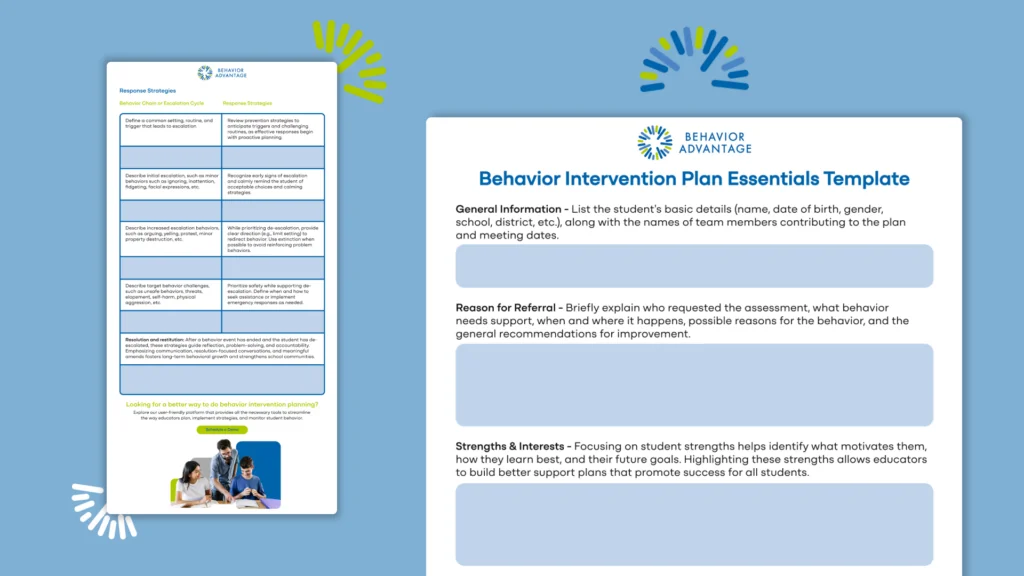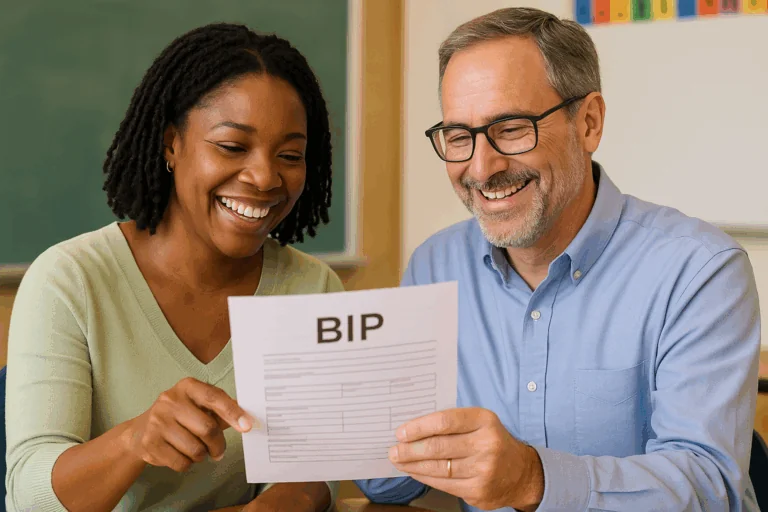Having a well-researched List of Behavior Intervention Strategies to pick and choose from can have many benefits for your students’ academic and personal development.
However, before you select and implement a behavior strategy to support a struggling student, consider a few important points first:
- Does the person implementing the strategy have a solid foundation in trust and a positive relationship with the student?
- Does the strategy match the functional needs of the student?
Considering these questions as you select and implement a behavior strategy will greatly improve the likelihood of the intervention having a positive effect on student behavior.
Download Our List of 20 Essential Behavior Intervention Strategies in a Handy PDF Format
Strategies to Develop a Solid Foundation in Trust and Positive Support
Building strong relationships with students is the foundation of all effective behavior strategies. When students feel safe, valued, and connected, they are far more likely to follow expectations and respond to interventions.
To begin with, every List of Behavior Intervention Strategies should include strategies like these three:
2 x 10 Strategy
Spend 2 minutes a day for 10 consecutive days having a personal, non-academic conversation with a student.
Benefits: Developed by psychologist Raymond Wlodkowski, this approach saw an 85% improvement in his students’ behavior. Watch the video below to find out how you can implement this strategy.
5 to 1 Ratio Strategy
Deliver frequent positive feedback to reinforce strong teacher-student relationships.
Benefits: This strategy increases academic engagement and lowers disruptions, resulting in a more positive classroom climate. Watch our short video to learn more about the types of feedback that you can use to encourage your students
Positive Greetings at the Door
Greet students with a warm welcome (verbal or non-verbal) as they enter the classroom to set a positive tone.
Benefits: A large study – comprising 203 students – saw this approach raise class engagement by 20% and cut disruptive incidents by 9%. Teachers confirm that greeting students builds rapport and creates a welcoming atmosphere.
These strategies are the key to developing a good Behavior Intervention plan. Check out our article on how to write a BIP that works for you and your students.
Strategies to Support Students with Attention/Connection-Seeking Behaviors
Some students seek attention in disruptive ways because they haven’t yet learned more appropriate ways to get it. An effective List of Intervention Behavior Strategies should include steps to help students gain positive attention efficiently and appropriately, while also teaching patience and self-regulation when immediate attention isn’t available.
Teach Hand Raising
Explicitly teach and reinforce when and how to appropriately get the teacher’s attention.
Benefits: For instance, show your students how to raise their hand, instead of them acting out. By giving attention quickly when the student raises a hand or participates properly, you reinforce the new behavior, gradually replacing the old attention-seeking antics.
Provide ‘Leadership’ Responsibilities
Assign meaningful classroom jobs or leadership roles to increase engagement and connection.
Benefits: A student craving attention can help around the classroom and receive praise for supporting others. This positive approach meets their attention needs and boosts their sense of belonging.
Strategic Seating
Place the student in a location where they have easier access to support and fewer distractions.
Benefits: Placing the student’s desk near the teacher allows frequent check-ins and subtle feedback. This proximity often curbs attention-seeking by making the student feel noticed and letting the teacher quickly reinforce good behavior.
Cueing Systems
Use subtle signals (e.g., hand gestures, visual cues) to remind students of expectations.
Benefits: A common technique is to create a subtle cue that reminds the student to use appropriate attention-seeking behavior. You can use a sticky note or pre-taught baseball signal, like an ear tug, to prompt the student to refocus or confirm they’ve been noticed.
Peer Support Strategies
Pair students with a buddy or peer mentor to provide social and academic support.
Benefits: This strategy teaches the student to seek connection through cooperation rather than disruption. Encourage positive peer interaction by seating the student near supportive classmates or letting them earn partner time for meeting behavior goals.
Strategies to Support Students with Work Avoidance or Refusal Behaviors
Some students avoid work because they find it too hard, too confusing, or overwhelming. Others may lack motivation or confidence. The next set of measures in our List of Behavior Intervention Strategies reduce task difficulty, increase clarity, and build momentum, helping students engage in learning without becoming overwhelmed.
Pre-teaching or Priming of Content
Give students a preview of new material to increase familiarity and reduce anxiety.
Benefits: If you are about to teach new material, have a brief one-on-one session with the student beforehand to review the essentials. Offering extra help before the task can ward off escape-driven behaviors.
Checklists or Task Analysis
Break tasks into smaller, manageable steps with a clear checklist to support completion.
Academic or Behavior Contracts
Create simple agreements outlining expectations and incentives to encourage follow-through.
Benefits: Research indicates these contracts boost student follow-through by linking effort to rewards. For instance, a student might earn a homework pass or fewer math problems if they stay focused and complete their work for a week.
Chunking
Present work in smaller, bite-sized sections to make tasks feel more manageable.
Benefits: If a student shuts down at the sight of 20 math problems, splitting them into five-problem sets can help. This prevents overload and provides frequent chances for positive reinforcement.
Behavior Momentum
Start with easy, high-success tasks before transitioning to more challenging work to build motivation.
Strategies to Support Students with Access Behaviors
Some students engage in problem behaviors to gain access to a preferred activity, object, or person. Remember that the goal of your List of Behavior Intervention Strategies should also be to teach students appropriate ways to request what they want and how to handle delays or denials without engaging in problem behavior.
Visual Choice Boards
Provide students with a visual menu of options to communicate needs and preferences.
Benefits: During free time, you can use a choice board showing different activities (reading, drawing, Lego, computer, etc.). Allowing such controlled choices boosts engagement and lowers challenging behaviors by acknowledging the student’s interests.
Functional Communication Training
Teach students alternative, appropriate ways to request what they want.
Benefits: One study examined children who were taught to say “I need help” or “I want a break”. Overall, this new form of communication showed substantial drops in their escape-motivated tantrums.
Teach Delayed Gratification
Help students practice waiting for desired items or activities through structured reinforcement.
Benefits: If a student impulsively grabs snacks, you set up a routine: the student asks first, uses a “wait card” and then receives the snack. This delayed gratification not only fosters an important self-regulation skill but also teaches functional communication.
Self-Management Strategies
Teach students to track their own behavior and progress using simple tools like checklists or self-reflection sheets.
Benefits: Research has demonstrated that practices, such as goal-setting and self-monitoring boost on-task engagement, cut disruptive behaviors, and nurture independence and responsibility.
If you are thinking about using some of these strategies in your Behavior Intervention Plan, download our free BIP template to get you started right away!
 Strategies to
Strategies to
Support Students with Self-Stimulatory Behaviors
Self-stimulatory behaviors (e.g., hand flapping, rocking, repetitive sounds) are often used by students to self-soothe, regulate emotions, or meet sensory needs. Finally, instead of trying to eliminate these behaviors completely, a definitive PDF List of Behavior Intervention Strategies needs to help students meet their sensory needs in appropriate and functional ways.
Environmental Enrichment
Provide access to preferred activities or tools (e.g., fidget items, movement breaks) to reduce excessive self-stimulatory behavior.
Prevention and Accommodation Strategies
Modify the classroom environment to minimize triggers and support sensory needs.
Benefits: By accommodating sensory needs, such as stretch breaks and stress balls, you support students’ self-regulation.This reduces the frequency and intensity of self-stimulatory behaviors and improves focus.
Teaching ‘Time and Place’ Strategies
Help students learn when and where certain behaviors are appropriate rather than trying to eliminate them entirely.
Benefits: Completely eliminating stimming may not be realistic or fair, given its stress-relief role. Instead, students can learn boundaries. This approach lets them self-stimulate more discreetly, reducing classroom disruptions while still respecting their needs.
These strategies can be used individually or in combination to support students with a wide range of behavior needs. Download our List of Behavior Intervention Strategies PDF to assist you in promoting positive changes in behavior.
All of these practical strategies—and many more—are easily accessible through Behavior Advantage, where educators can quickly identify, implement, and track function-based interventions for students.
Need advice about how to implement different Behavior Intervention Strategies? Discover our streamlined platform designed to support behavior planning, MTSS teams and teachers can confidently choose strategies that align with each student’s needs and see real progress over time.









